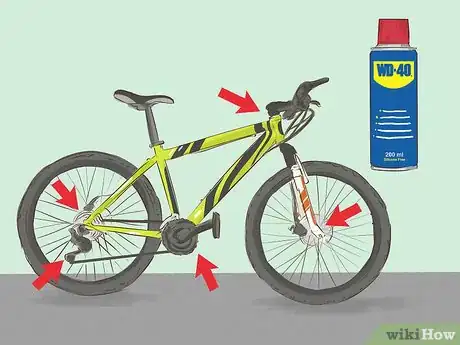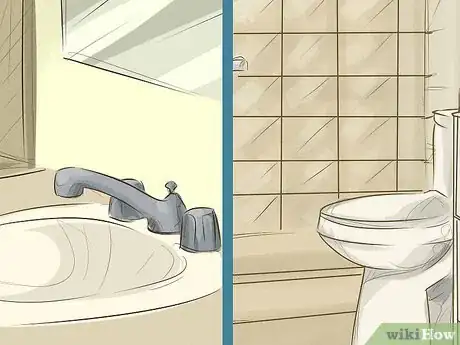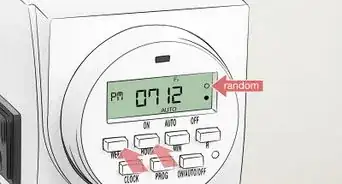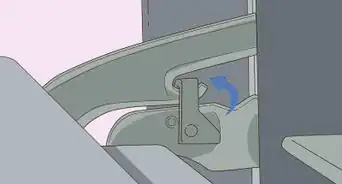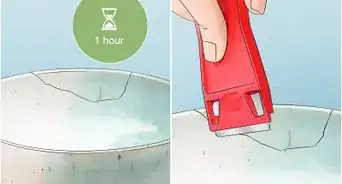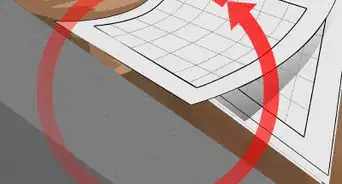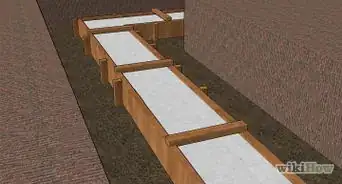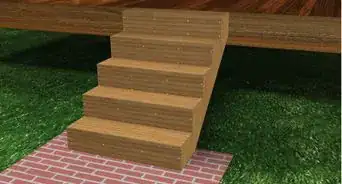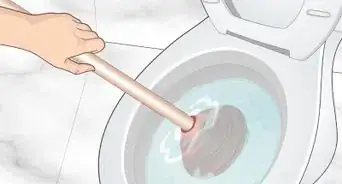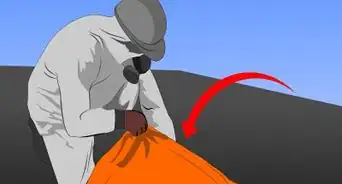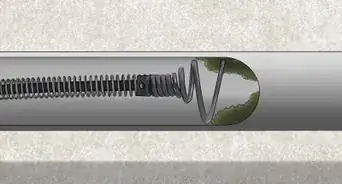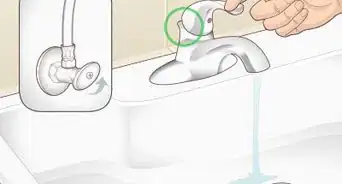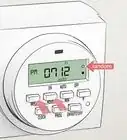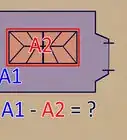This article was co-authored by Josh Goldenberg. Josh Goldenberg is a Residential Remodeling Expert and the Co-Founder of 5blox, based in the Greater Los Angeles area. With more than seven years of experience, Josh and his team specialize in luxurious and sustainable home renovations. 5blox is fully licensed and bonded.
There are 10 references cited in this article, which can be found at the bottom of the page.
This article has been viewed 15,840 times.
WD-40 is a pressurized spray lubricant, and is commonly sold in hardware stores, home-supply stores, and even supermarkets. The product can be used for a large variety of household applications, but is most commonly applied to rusted or lubricating joints or hinges that open with difficulty. WD-40 can also be used for a variety of cleaning purposes, and is a more versatile home supply than many users realize, due to its ability to break down nearly all forms of grease, oils, and adhesives.
Steps
Using WD-40 Inside Your Home
-
1Remove gum, rubber cement, and general adhesives. WD-40 will break down most general types of adhesive and clean them off of nearly all surfaces. For example, spray WD-40 on jars to remove the adhesive remnants of the labels or masking tape, or use it to remove the adhesive from stickers on glass or plastic surfaces. WD-40 can also loosen and remove gum and rubber cement from surfaces they have been stuck to. Spray WD-40 directly onto the unwanted adhesive, and use a rag or old toothbrush to remove the substance.[1]
- WD-40 will even work to clean gum, oil, or dog poop off of the soles of your shoes. In any of these cases, spray WD-40 directly onto the adhesive substance, and then scrub vigorously with an old, unused toothbrush.
-
2Soften and break in leather shoes. New or unused leather shoes that have not been worn recently are often inflexible and can be uncomfortable to slide your foot into or wear for a day. You can use WD-40 to soften the leather and make the shoes comfortable to wear. To soften the leather, spray WD-40 generously over the leather material, and rub the material into the shoe with a clean, dry cloth.[2]
- An application of WD-40 will also soften any other leather items, from dog collars to baseball gloves.
- WD-40 can also be used to clean scuff marks off of the tops and sides of shoes. Black scuff marks build up from normal use and wear (including from the shoes bumping together as you walk). To remove scuffs, spray the marked area with WD-40 and buff with a dry cloth.
Advertisement -
3Remove grease stains from your clothing. As WD-40 is grease-resistant and can break down stubborn adhesives in general, it can even be used to remove grease stains from clothing. To remove the stain, hold the plastic extension tube only about ½ inch away from the stain, and spray liberally to saturate the area. Then wash the piece of clothing in a regular cycle.[3]
- Before drying the clothing, make sure that the stain has been removed. Drying—especially on medium or high heat—can set the stain and make it impossible to get out. If the stain has not been removed after an initial application of WD-40, repeat the application and wash again.
Using WD-40 Around the Yard and Garden
-
1Loosen rusty garden shears. If you haven’t used your garden shears in years, and especially if they’ve developed patches of rust, they may be difficult to open. If this is the case, spray WD-40 directly onto the joint between the two blades of the shears. Slowly work the handles back and forth to allow the WD-40 to soak in.[4]
- If your garden shears continue to not open—or to open only with difficulty—loosen the screw or bolt at the intersection of the blades, and spray some WD-40 between the sections of metal that rub together to lubricate. Screw the blades back together.
-
2Prevent rust buildup on tools and appliances. In addition to loosening moving parts that have stuck together, WD-40 can also prevent rust from building up. If you’re worried about unused tools or metal appliances developing rust, spray with WD-40 to prevent the rust from building up.[5] Hold the tip of the plastic extension tube 2–3 inches from the metal surface you’d like to keep from rusting, and coat the metal with a thin layer of fluid.
- This is useful for a number of outdoor gardening and lawn supplies. Apply WD-40 to your shovel, rake, hoe, saws and saw blades, as well as any outdoor appliances that are exposed to wet or humid weather.[6]
-
3Apply to moving parts on your bicycle. WD-40 is great at maintaining the motion and smoothness of any moving mechanical parts, including the wheel sprockets, chain, handlebars, and pedal mechanism on your bicycle. WD-40 makes several bicycle-specific products for use on various parts of your bike. These include a general de-greaser, chain lubricant, and frame protectant. When possible, use bicycle-specific WD-40 products on your equipment.[7]
- These products should be available at your local bike-supply shop, a hardware store, or from various online bicycle-focused retailers.
Cleaning with WD-40
-
1Spray onto stainless-steel appliances to clean and shine them. WD-40 can remove dust and grime from stainless-steel appliances, including your refrigerator, stovetop, dishwasher, laundry machine, and clothes dryer.[8] Spray the WD-40 onto dirty areas from about 2–3 inches away, and let sit for a couple of minutes before wiping down with a wet rag or a soapy sponge.
- Although WD-40 can be used to remove splattered grease around kitchen in general, it’s less effective for this purpose than soap and water, or a general-purpose cleaner like Windex.[9]
-
2Clean tiles and grout with WD-40. The lubricating properties of WD-40 make it a useful for loosening dirt and grime in hard-to-reach places, including between kitchen or patio tiles. Hold the tip of the plastic extension tube about 1 inch away from the tiles or sections of grout that you wish to clean, and spray liberally. Let the fluid sit for a few minutes, and then clean up with soapy water.[10]
- This method will clean a variety of substances off of tile, in addition to general dirt and grime, including: paint, scuff marks, makeup, and nail polish.
-
3Clean stains from your toilet, sink, and bathtub. Many porcelain surfaces in the bathroom are stained by mineral buildup from hard water. Other stains build up on these bathroom amenities as well, including some that may be left behind by other cleaning supplies. You can remove these by spraying WD-40 directly onto the stain, and then and then scrub vigorously with your toilet brush (or a sponge).[11]
- You should not use WD-40 to replace regular toilet cleaner, as WD-40 cannot kill germs and bacteria. Rather, only use WD-40 to remove specific stains that general toilet cleaner can’t remove.
- WD-40 can be used to remove stains from other surfaces made of porcelain (or a similar substance). For example, use it in your kitchen or dining room to remove stains made from tea or coffee cups.[12]
Expert Q&A
-
QuestionCan you use WD-40 on metal?
 Josh GoldenbergJosh Goldenberg is a Residential Remodeling Expert and the Co-Founder of 5blox, based in the Greater Los Angeles area. With more than seven years of experience, Josh and his team specialize in luxurious and sustainable home renovations. 5blox is fully licensed and bonded.
Josh GoldenbergJosh Goldenberg is a Residential Remodeling Expert and the Co-Founder of 5blox, based in the Greater Los Angeles area. With more than seven years of experience, Josh and his team specialize in luxurious and sustainable home renovations. 5blox is fully licensed and bonded.
Residential Remodeling Expert Definitely! WD-40 is great to use to keep power tools lubricated and in good working condition even after years of use. It's also great for loosening tight or stuck plumbing joints/rusted bolts, or even an outdoor gate that has had some rust accrue.
Definitely! WD-40 is great to use to keep power tools lubricated and in good working condition even after years of use. It's also great for loosening tight or stuck plumbing joints/rusted bolts, or even an outdoor gate that has had some rust accrue.
Warnings
- When using WD-40, make sure to stand in a well-ventilated area. Point the plastic extension tube directly at the area you wish to apply the WD-40 to, and bring it as close as possible before spraying. Never inhale WD-40, and never spray directly towards your (or anyone else’s) face.⧼thumbs_response⧽
References
- ↑ http://www.stain-removal-101.com/wd-40.html
- ↑ https://www.bobvila.com/slideshow/9-unusual-ways-to-use-wd-40-48621/best-way-to-clean-leather
- ↑ http://www.dooleynotedblog.com/2012/02/13/wd-40/
- ↑ Josh Goldenberg. Residential Remodeling Expert. Expert Interview. 25 January 2022.
- ↑ Josh Goldenberg. Residential Remodeling Expert. Expert Interview. 25 January 2022.
- ↑ http://www.snopes.com/inboxer/household/wd-40.asp
- ↑ http://www.velonews.com/2013/11/bikes-and-tech/reviewed-wd-40-bike-products_309244
- ↑ http://howdoesshe.com/uses-for-wd40-around-the-house/
- ↑ http://www.snopes.com/inboxer/household/wd-40.asp






